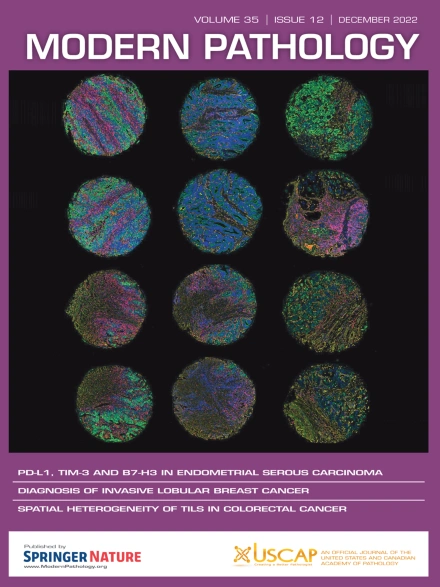A Deep Learning Model of Histologic Tumor Differentiation as a Prognostic Tool in Hepatocellular Carcinoma
IF 5.5
1区 医学
Q1 PATHOLOGY
引用次数: 0
Abstract
Tumor differentiation represents an important driver of the biological behavior of various forms of cancer. Histologic features of tumor differentiation in hepatocellular carcinoma (HCC) include cytoarchitecture, immunohistochemistry profile, and reticulin framework. In this study, we evaluate the performance of an artificial intelligence (AI)–based model in quantifying features of HCC tumor differentiation and predicting cancer-related outcomes. We developed a supervised AI model using a cloud-based, deep learning platform to quantify histologic features of HCC differentiation, including various morphologic parameters (nuclear density, area, circularity, chromatin pattern, and pleomorphism), mitotic figures, immunohistochemistry markers (HepPar 1 and glypican-3), and reticulin expression. We applied this AI model to patients undergoing HCC curative resection and assessed whether AI-based features added value to standard clinical and pathologic data in predicting HCC-related outcomes. Ninety-nine HCC resection specimens were included. Three AI-based histologic variables were most relevant to HCC prognostic assessment: (1) percentage of tumor occupied by neoplastic nuclei (nuclear area percent), (2) quantitative reticulin expression in the tumor, and (3) HepPar 1 low (ie, expressed in <50% of the tumor)/glypican-3–positive immunophenotype. Statistical models that included these AI-based variables outperformed models with combined clinical pathologic features for overall survival (C-indexes of 0.81 vs 0.68), disease-free survival (C-indexes of 0.73 vs 0.68), metastasis (C-indexes of 0.78 vs 0.65), and local recurrence (C-indexes of 0.72 vs 0.68) for all cases, with similar results in the subgroup analysis of World Health Organization grade 2 HCCs. Our AI model serves as a proof of concept that HCC differentiation can be objectively quantified digitally by assessing a combination of biologically relevant histopathologic features. In addition, several AI-derived features were independently predictive of HCC-related outcomes in our study population, most notably nuclear area percent, hepar-low/glypican-3–negative phenotype, and decreasing levels of reticulin expression, highlighting the relevance of quantitative analysis of tumor differentiation features in this context.
肿瘤组织学分化的深度学习模型作为肝细胞癌的预后工具。
肿瘤分化是各种癌症生物行为的重要驱动因素。肝细胞癌(HCC)肿瘤分化的组织学特征包括细胞结构、免疫组织化学特征和网状蛋白框架。在这项研究中,我们评估了基于人工智能(AI)的模型在量化HCC肿瘤分化特征和预测癌症相关结局方面的表现。我们使用基于云的深度学习平台(Aiforia Technologies)开发了一个有监督的人工智能模型,以量化HCC分化的组织学特征,包括各种形态学参数(核密度、面积、圆形度、染色质模式和多形性)、有丝分裂图、免疫组织化学标志物(hepar1和glypican-3)和网状蛋白表达。我们将该人工智能模型应用于接受HCC根治性切除术的患者,并评估基于人工智能的特征在预测HCC相关结果方面是否为标准临床和病理数据增加了价值。纳入99例HCC切除标本。三个基于人工智能的组织学变量与HCC预后评估最相关:1。肿瘤核占肿瘤的百分比(核面积%);3.网状蛋白在肿瘤中的定量表达;肝素-1低(即在不到50%的肿瘤中表达)/glypican-3阳性免疫表型。包含这些基于人工智能的变量的统计模型在所有病例的总生存期(c -指数为0.81比0.68)、无病生存期(c -指数为0.73比0.68)、转移期(c -指数为0.78比0.65)和局部复发(c -指数为0.72比0.68)方面优于结合临床病理特征的模型,在WHO 2级hcc的亚组分析中结果相似。我们的人工智能模型可以作为概念证明,通过评估生物学相关的组织病理学特征的组合,可以客观地量化HCC分化。此外,在我们的研究人群中,一些人工智能衍生的特征可以独立预测hcc相关的结果,最显著的是核面积%、低肝/ 3型阴性表型和网状蛋白表达水平的降低,突出了在这种情况下定量分析肿瘤分化特征的相关性。
本文章由计算机程序翻译,如有差异,请以英文原文为准。
求助全文
约1分钟内获得全文
求助全文
来源期刊

Modern Pathology
医学-病理学
CiteScore
14.30
自引率
2.70%
发文量
174
审稿时长
18 days
期刊介绍:
Modern Pathology, an international journal under the ownership of The United States & Canadian Academy of Pathology (USCAP), serves as an authoritative platform for publishing top-tier clinical and translational research studies in pathology.
Original manuscripts are the primary focus of Modern Pathology, complemented by impactful editorials, reviews, and practice guidelines covering all facets of precision diagnostics in human pathology. The journal's scope includes advancements in molecular diagnostics and genomic classifications of diseases, breakthroughs in immune-oncology, computational science, applied bioinformatics, and digital pathology.
 求助内容:
求助内容: 应助结果提醒方式:
应助结果提醒方式:


